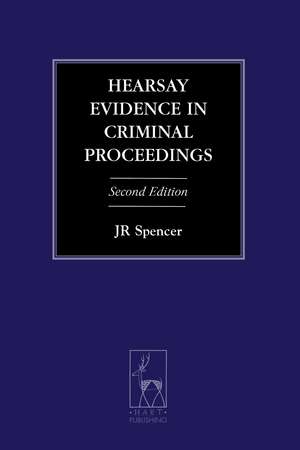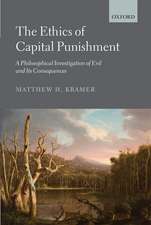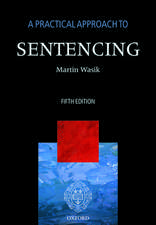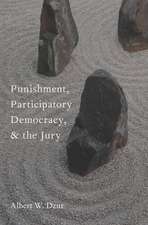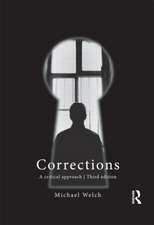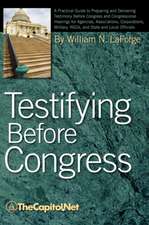Hearsay Evidence in Criminal Proceedings: Criminal Law Library
Autor J. R. Spenceren Limba Engleză Paperback – 20 feb 2014
Preț: 361.16 lei
Preț vechi: 413.68 lei
-13% Nou
Puncte Express: 542
Preț estimativ în valută:
69.12€ • 75.05$ • 58.06£
69.12€ • 75.05$ • 58.06£
Carte tipărită la comandă
Livrare economică 22 aprilie-06 mai
Preluare comenzi: 021 569.72.76
Specificații
ISBN-13: 9781849464635
ISBN-10: 1849464634
Pagini: 506
Dimensiuni: 156 x 234 x 15 mm
Greutate: 0.77 kg
Ediția:Revised
Editura: Bloomsbury Publishing
Colecția Hart Publishing
Seria Criminal Law Library
Locul publicării:London, United Kingdom
ISBN-10: 1849464634
Pagini: 506
Dimensiuni: 156 x 234 x 15 mm
Greutate: 0.77 kg
Ediția:Revised
Editura: Bloomsbury Publishing
Colecția Hart Publishing
Seria Criminal Law Library
Locul publicării:London, United Kingdom
Caracteristici
The book contains a section-by-section commentary on the relevant provisions of the Criminal Justice Act 2003, discussing the case-law that had interpreted them.
Notă biografică
JR Spencer KC is Professor of Law in the University of Cambridge and a Fellow of Selwyn College, Cambridge.
Cuprins
1 Introduction Hearsay rule and the rise and fall of the exclusionary rules of evidence Scope and evolution of the hearsay rule Hearsay rule in criminal law as it stood before the 2003 reform: Justifications for the rule Criticisms of the hearsay rule Hearsay rule as seen by legal writers The 'directness principle' or 'best evidence' approach Abolition of the hearsay rule in civil proceedings Background to the 2003 reform: Criminal Law Revision Committee, Fraud Trials Committee, Law Commission and Auld Review Reform: Criminal Justice Act 2003, Part 11, Chapter 2 Conclusion: provisional assessment of the reform Scope Date of entry into force 2 Hearsay and the European Convention on Human Rights The confrontation principle ECHR, Article 6 (3)(d) Who is a 'witness' for the purposes of ECHR, Article 6(3)(d)? What is meant by 'a right to examine or have examined witnesses against him'? To what extent, if any, is it ever possible to base a conviction on the evidence of a witness or witnesses whom the defendant was unable to 'examine or have examined', without infringing his rights under ECHR, Article 6(3)(d)? The defendant's right to confrontation-the case for a new system of taking evidence ahead of trial 3 The scope of the reform, the shape of the new exclusionary rule and the new scheme of exceptions General scope of the new law Abolition of the common law exclusionary rule: the demise of Kearley The new exclusionary rule: CJA 2003, sections 114(1) and 115 The new definition of hearsay: conclusion Scheme of exceptions 4 Hearsay admitted by agreement 5 The 'inclusionary discretion' and the general discretion to exclude Discretionary inclusion under CJA 2003, section 114(1)(d): 'safetyvalve' or alternative tap? What are 'the interests of justice'? Particular applications of section 114(1)(d) Discretionary exclusion: PACE, section 78 and CJA 2003, section 126 6 Statements of witnesses who are unavailable (CJA 2003, section 116) History: earlier provisions The new provision: CJA 2003, section 116 7 Documentary hearsay (CJA 2003, section 117) History Underlying issue: 'records' of different types CJA 2003, section 117 Extra conditions for the admissibility of police records Discretion to exclude Documentary evidence and real evidence CJA 2003, section 117: conclusion 8 Other statutory exceptions 9 Preserved common law exceptions (CJA 2003, section 118) Public information, etc Reputation as to character Reputation or family tradition Res gestae Confessions, etc Admissions by agents, etc Common enterpriseExpert evidence 10 Confessions (and other extra-judicial statements by defendants) Introduction Defendant's extra-judicial confession as evidence for the prosecution 1Defendant's extra-judicial 'non-confession' as evidence for the defence: mixed statements', etc Extra-judicial statement of one co-defendant as evidence against another Extra-judicial statements of one co-defendant as evidence for another Defendant's extra-judicial statements: conclusion 11 Multiple hearsay 12 The rule against narrativeIntroduction Rule against narrative is retained Rules about 'refreshment of memory' are relaxed Other common law exceptions to the rule are reformed and put into statutory form Where the previous statement of a witness is admissible, it is now 'evidence of any matter stated in it' A practical point: a previous statement, if in documentary form, must not normally be given to the jury when it retires The rule against narrative: conclusion 13 Videotaped evidence-in-chief Introduction Background Annex: Youth Justice and Criminal Evidence Act 1999, section 27 14 Other matters: experts (CJA 2003, section 127) and proof of documents (section 133) Expert evidence: preparatory work Documents: evidential status of a copy15 Practical issues Taking, recording and preservation of statements, and the rules on access to them Evidence on commission Requirement to give notice of hearsay evidence: criminal procedure rules Deciding applications to admit hearsay evidence and applications for hearsay to be excluded Time and place for deciding on the application Giving reasons for the decision Credibility of non-witnesses whose statements are admitted Enhanced status of a witness's previous statements Stopping the case where the evidence is unconvincing Directing juries
Descriere
This book provides a section-by-section commentary on the relevant provisions of the Act, discussing the case-law that had interpreted them. The commentary has been revised in light of the new developments arising from several new leading cases.
